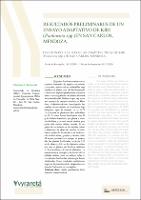Resultados preliminares de un ensayo adaptativo de Kiri (Paulownia spp.) en San Carlos, Mendoza
Preliminary results of an adaptive trial of Kiri (Paulownia spp.) in San Carlos, Mendoza.
Abstract
El género Paulownia reúne varias especies forestales de rápido crecimiento y presenta características maderables muy similares al álamo, por ello ha despertado el interés en algunos productores, extensionistas e investigadores vinculados al sector foresto-industrial. Debido a que hay escasos reportes de ensayos técnicos en Mendoza, el objetivo de esta investigación fue evaluar el crecimiento de Paulownia bajo diferentes tipos de manejo. En el INTA La Consulta se plantaron diez individuos en 2017: cinco fueron fertilizados con 30 g de fosfato diamónico por planta y cinco sin fertilizar, y se usó manta térmica para protección contra heladas tardías. Se registró el crecimiento de los árboles (altura y diámetro a la altura del cuello), se efectuaron podas de formación y se evaluó el efecto de la nieve, granizo y vientos. A los 18 meses posteriores al recepe, en promedio, las plantas fertilizadas crecieron 5,13 m de altura y 6,8 cm de diámetro; mientras que las plantas sin fertilizar midieron 2,18 m de altura y 4,5 cm de diámetro. La manta térmica protegió a los brotes de las heladas tardías, pero no influyó sobre el crecimiento final en las plantas que fueron fertilizadas. Estos resultados preliminares sugieren la posibilidad de adaptación exitosa de Paulownia en esta región. The genus Paulownia brings together several fast-growing forest species and presents wood characteristics very similar to poplar, which has attracted the interest of forest growers, extension workers and forestry researchers. Because there are few reports of technical trials in Mendoza, the objective of this research was to evaluate growth of Paulownia trees under different management conditions.. At INTA La Consulta, ten individuals were planted in 2017: five were fertilized with 30 g of diammonium phosphate, five remained unfertilized, and thermal blanket was used to protect against late frosts. Tree growth (height and diameter at neck height) was registered, formation pruning was carried out, and the effect of snow, hail and winds was taken into account. Eighteen months after the coppicing, on average, the fertilized plants grew 5.13 m in height and 6.8 cm in diameter; while the unfertilized plants measured 2.18 m in height and 4.5 cm in diameter. The thermal blanket protected the shoots from late frosts, but did not influence the final growth in the plants that were fertilized. These preliminary results suggest the possibility of successful adaptation of Paulownia in this region.
Collections
- Revista Yvyraretá [360]
The following license files are associated with this item:



